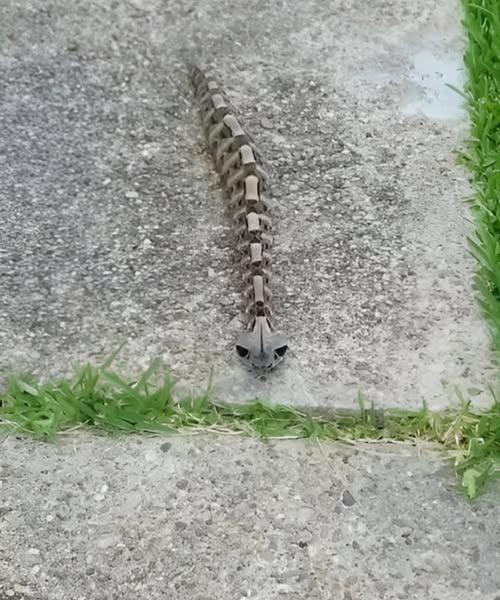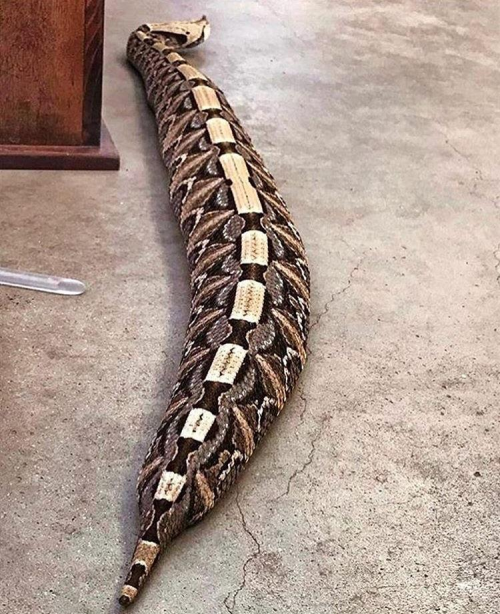The Deadliest Snake You Might Never See Coming
Imagine walking through a rainforest and stepping onto what looks like a pile of leaves—only to discover it’s a six-foot-long, 45-pound venomous snake. That’s the terrifying magic of the Gaboon viper, a master of camouflage and one of the most dangerous snakes in the world. With its breathtaking patterns, incredibly long fangs, and the ability to disappear into the forest floor, this snake isn’t just lethal—it’s a work of evolutionary art.
But as beautiful as it is deadly, the Gaboon viper isn’t just living in the wild anymore. A few people—believe it or not—have kept these creatures as exotic pets, and the consequences have been catastrophic.

A Close Call in North Carolina: 44 Doses of Anti-Venom
Let’s start with one of the most jaw-dropping survival stories. In North Carolina, a man was bitten by his pet Gaboon viper—and miraculously lived to talk about it. Medical professionals treating him said they’d never seen anyone survive such a venomous bite. It took 44 doses of anti-venom, the highest number ever used in a single case by the team overseeing his treatment.
The man lost two fingers—but kept his life. And in the world of Gaboon viper bites, that’s a rare outcome. These snakes don’t bite often, but when they do, their venom can cause rapid tissue destruction, paralysis, or death if not treated immediately.
Video: The snake you DONT want to see 👀
Gaboon Viper Facts: Beauty Meets Brutality
Let’s get to know this incredible species up close—without risking your fingers.
- Longest fangs of any venomous snake, measuring up to 2 inches (5 cm)
- Heaviest viper in Africa, growing over 6 feet long and weighing more than 45 pounds
- Venom capacity that can drop large prey in seconds
- Camouflage masters, with pink, brown, and purple markings that resemble dead leaves
- Live birth producers (most snakes lay eggs), often having up to 60 babies at once
These snakes live in rainforests and wet savannahs across sub-Saharan Africa, where they blend perfectly into the leaf-littered ground. Their hunting method is passive but deadly—they wait, completely still, until a bird or small mammal passes by. Then, in a blink, they strike with surgical precision.
The Art of Ambush: How Gaboon Vipers Hunt
Here’s the terrifying part. These vipers don’t slither around searching for food. They hide in plain sight.
Their markings—those mesmerizing leaf-like patterns—let them vanish into the forest floor. They’re ambush predators, relying on surprise rather than speed. When prey gets close enough, they unleash those giant fangs and inject venom that takes effect almost instantly.
Even more incredible? Gaboon vipers can control the amount of venom they release. Some bites are dry. Others? Fatal in minutes.

Rarely Aggressive, But Highly Dangerous
Despite their fearsome reputation, Gaboon vipers are actually calm and shy. They don’t go looking for a fight. Most bites happen when people accidentally step on them or provoke them without realizing it. When threatened, they lift their massive heads, hiss, and give you a very clear warning before striking.
They hunt solo, mostly at night or around dusk. And unless they’re extremely hungry, they tend to ignore anything too large to swallow. That includes humans—usually.
Another Scare in Virginia: Anti-Venom on Speed Dial
Not long after the North Carolina case, a similar situation unfolded in Virginia. Another man kept a Gaboon viper as a pet. And again, it bit him.
This time, it triggered a statewide emergency response. Anti-venom had to be rushed from both the Virginia Aquarium and the Smithsonian National Zoo. The Virginia Aquarium alone provided 35 doses. That gives you an idea of just how serious these bites are—and how unprepared local hospitals can be for exotic snake incidents.
Video: Gaboon viper moves like a caterpillar 🐛
The Risk of Exotic Snake Ownership
Here’s the thing: keeping a Gaboon viper isn’t like having a pet goldfish. These creatures are wild by nature, and they come with deadly consequences when mishandled.
The biggest issue? Anti-venom. It’s not stocked in your average hospital. It’s often expensive, limited, and only available through zoos, aquariums, or specialized poison centers. In an emergency, every second counts—and locating the right treatment could be the difference between life and death.
Doctors and herpetology experts constantly warn against keeping exotic venomous reptiles without proper permits, facilities, and experience. And even then, the risk never goes away.
Separating Myth From Reality: Are All Snakes Dangerous?
Let’s clear something up: not all snakes are dangerous. In fact, most snakes you’ll find in your backyard or garage are harmless. They don’t want to bite. They don’t want to chase you. And they definitely don’t want to be your enemy.
As Kortney Jaworski, a herpetology curator at the Virginia Living Museum, put it: “Snakes by nature are not aggressive animals.” They’re more afraid of you than you are of them.
And if you do get bitten? Forget those old movie myths. Don’t suck the venom. Don’t cut the wound. And whatever you do, don’t use a tourniquet. Just stay calm, call for help, and get to a hospital as fast as you can.
Conclusion: Respect the Snake, Admire From Afar
The Gaboon viper is one of the most mysterious and awe-inspiring animals on the planet. Its beauty is mesmerizing. Its venom is deadly. Its design—flawless in function and form—is a reminder that nature can be both magnificent and merciless.
But here’s the key takeaway: admire it from a distance. This isn’t a creature meant for living rooms or exotic pet collections. It’s a wild predator with instincts and power that deserve deep respect.
So the next time you see a photo of a Gaboon viper—camouflaged, coiled, and quiet—just remember: the most dangerous things in nature are often the most beautifully hidden.